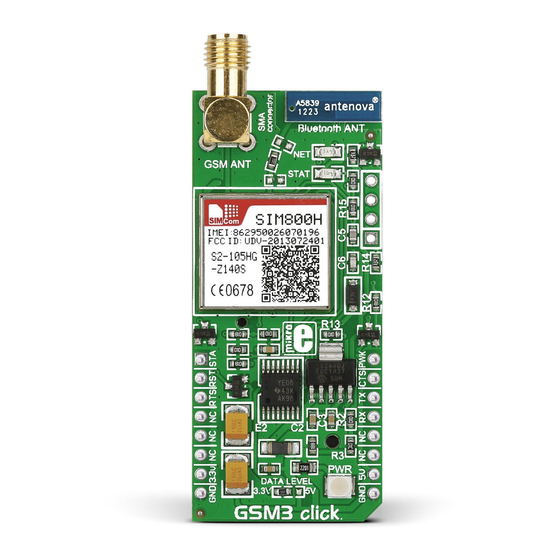
Advertisement
Quick Links
GSM3
click
™
1. Introduction
carries SIM800H, a quad-band
GSM3 click
™
(850/900/1800/1900MHz) GSM/GPRS
module that transmits voice, sms and data
information. The board communicates
with the target board MCU through the
following mikroBUS
lines: Tx and Rx
™
(UART), RST (reset), GP1 (status indicator),
GP2 (RTS), GP3 (GPIO1), GP4 (PWRKEY,
used to power on/off the module) and GP5
(CTS). GSM3 click
is designed to use 3.3V
™
and 5V I/O voltage levels.
2. Soldering the headers
Before using your click
board, make sure
™
to solder 1x8 male headers to both left
and right side of the board. Two 1x8 male
headers are included with the board in
the package.
2
Turn the board upside down so that
the bottom side is facing you upwards.
Place shorter pins of the header into the
appropriate soldering pads.
1
3
Turn the board upward again. Make sure
to align the headers so that they are
perpendicular to the board, then solder
the pins carefully.
3. Plugging the board in
Once you have soldered the headers your
board is ready to be placed into the desired
mikroBUS
™
socket. Make sure to align the
cut in the lower-right part of the board with
the markings on the silkscreen at the
mikroBUS
socket. If all the pins
™
are aligned correctly, push the
board all the way into the socket.
4. Essential features
The underside of GSM3 click
holds the SIM
™
card slot. Aside from that the click
™
has the
following additional features: audio input/
output connection pad (for microphone
and earphones, can also be used as an FM
antenna). The STM800H module supports
Bluetooth so the click
has an active
™
2.4GHz antenna. A connector for an
external GSM antenna is also provided.
Two indication LEDs signal the operating
and network status of the module.
click
™
BOARD
www.mikroe.com
GSM3 click
manual
™
ver 1.00
0 1 0 0 0 0 0 0 7 2 1 3 4
Advertisement

Summary of Contents for mikroElektronika GSM3 click SIM800H
- Page 1 2. Soldering the headers Before using your click board, make sure ™ to solder 1x8 male headers to both left and right side of the board. Two 1x8 male headers are included with the board in the package. GSM3 click 4.
- Page 2 MikroElektronika assumes no responsibility or liability for any errors or inaccuracies that may appear in the present document. Specification and information contained in the present schematic are subject to change at any time without notice. Copyright © 2014 MikroElektronika. All rights reserved.
















Need help?
Do you have a question about the GSM3 click SIM800H and is the answer not in the manual?
Questions and answers